GM New Look bus
| GM New Look | |
|---|---|
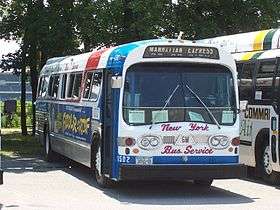 A restored GM “New Look” bus of the former New York Bus Service | |
| Overview | |
| Manufacturer |
GM Truck and Bus (United States) GM Diesel Division (Canada) |
| Production |
|
| Assembly | |
| Body and chassis | |
| Class | Transit bus |
| Body style | Monocoque stressed-skin |
| Powertrain | |
| Engine |
|
| Transmission |
|
| Dimensions | |
| Wheelbase | 162 in (4.11 m), 235 in (5.97 m), or 285 in (7.24 m)[1] |
| Length | 29 ft (8.8 m), 35 ft (10.7 m), or 40 ft (12.2 m) |
| Width | 96 in (2.44 m) or 102 in (2.59 m) |
| Height |
121 in (3.07 m) (height over roof hatches)[1] |
| Chronology | |
| Predecessor | GM/Yellow Coach "old look" |
| Successor |
|
The GM New Look bus, also commonly known by the nickname "Fishbowl" (for its six-piece rounded windshield), is a transit bus introduced in 1959 by Truck and Coach Division of General Motors and produced until 1986.[2] More than 44,000 New Look buses were built. Its high production figures and long service career made it an iconic North American transit bus. The design is listed as U.S. Patent D182,998 by Roland E. Gegoux and William P. Strong.
Production overview
44,484 New Look buses were built over the production lifespan, of which 33,413 were built in the U.S. and 11,071 were built in Canada (GM Diesel Division). Separated by general type, the production figures comprised 510 29-foot (8.8 m) city buses (all U.S.-built); 9,355 35-foot (10.7 m) city buses (7,804 U.S.-built, 1,551 Canadian); 31,348 40-foot (12.2 m) city buses (22,034 U.S., 9,314 Canadian) and 3,271 suburban coaches (of which only 206 were built in Canada).[1] The total production of New Looks was 41,213 transit coaches and 3,271 suburban coaches.[1]
Other than demonstrators, Washington, D.C. was the very first city to take delivery of any GM New Look buses, specifically TDH-5301s built in 1959 for O. Roy Chalk's D.C. Transit System,[3] which operated in Washington, D.C., and the suburbs of Maryland and Virginia.
Several different models were introduced over the following years, and modifications made to the design. See the section below, headed "Description".
Production of the New Look in the U.S. ceased in 1977,[1] when it was replaced by the RTS transit bus. Production continued after this, however, at General Motors Diesel Division in Canada, due to the RTS design being rejected by Canadian transit agencies, with the name plate changing from "GM" to "GMC". Few were produced after 1983 due to the GMDD's introduction of the Classic in that year. The last New Looks to be built were an order for Santa Monica Municipal Bus Lines (now Big Blue Bus) of Santa Monica, California in 1986.[2] The completion of that order brought a final end to New Look production in April 1986.[2][4] A few transit systems are still operating them to this day (including Societe de transport de l'Outaouais in Gatineau, Quebec[5]), over 50 years after introduction and over 25 years after mass production ended.
The last American-built New Look GM buses were ordered by the city of Wausau, Wisconsin, which placed an order for twelve 35-foot (10.7 m) transit buses, model T6H-4523N, the last of which was delivered in March 1977.
The GM Buffalo bus, a group of intercity bus models built between 1966 and 1980, shared many mechanical and body parts with the fishbowl models, and were discontinued by the Pontiac, Michigan plant shortly after the RTS replaced fishbowl model production there.
GM later sold the rights to produce both Classic and RTS models to other manufacturers, and exited the heavy-duty transit and intercity markets for full-sized buses, although production of some medium-duty and light-duty chassis products sold in these markets continued.
Description
Like GM's over-the-road buses, including the Greyhound Scenicruiser, the air-sprung New Look did not have a traditional ladder frame. Instead it used an airplane-like stressed-skin construction in which an aluminum riveted skin supported the weight of the bus. The wooden floor kept the bus's shape. The engine cradle was hung off the back of the roof. As a result, the GM New Look weighed significantly less than competitors' city buses.
Virtually all New Look buses were powered by Detroit Diesel 71-series two-cycle Diesel engines. The original engine was the 6V71 (V6). GM buses used a unique "Angle-drive" configuration with a transverse mounted engine. The transmission angled off at a 45-or-so degree angle to connect to the rear axle. The engines were canted backwards for maintenance access; in fact, the only parts not accessible from outside the bus were the right-hand exhaust manifold and the starter. The entire engine-transmission-radiator assembly was mounted on a cradle that could be quickly removed and replaced, allowing the bus to return to service with minimal delay when the powertrain required major maintenance. Originally, all New Looks were powered by the 6V-71. GM resisted V8 power but eventually gave in to pressure from customers.
(The exception to the above was the 29-foot (8.8 m) TDH-3301, which was powered by the GMC DH-478 Toroflow four-stroke V6, and had a more conventional T-drive transmission.)
Original transmission choices were a four-speed non-synchronized manual transmission with solenoid reverse and the Allison Automatic VH hydraulic transmission. The latter was essentially a one-speed automatic transmission which drove the wheels through a torque converter. At sufficient speed a clutch bypassed the torque converter and the engine drove the rear wheels directly. A later option was the VS-2, similar to the VH but with a two-speed planetary gearset with three modes: Hydraulic, direct (1:1), and direct-overdrive. The very last batch of American-built New Looks and most Canadian-built New Looks from 1977 through 1987 use the Allison V730 transmission, a traditional three-speed automatic with a lockup torque converter. These four transmissions were the only V-drive transmissions made.
New Looks were available in both Transit and Suburban versions. Transits were traditional city buses with two doors; Suburbans had forward-facing seats (four-abreast), underfloor luggage bays, and had only one door. The center aisle of the Suburbans was lower than the floor beneath the seats, to accommodate the luggage bays. There were also "Suburban-style" transits which had forward-facing seats on slightly raised platforms that gave the appearance of a dropped center aisle. GM refused to install lavatories on its buses; at least one transit authority Sacramento Transit Authority in Sacramento, California added its own.
The New Look was built in 30 ft (9.1 m), 35 ft (10.7 m) and 40 ft (12.2 m) lengths and 96 and 102 in (2.44 and 2.59 m) widths. 35 and 40 ft (10.7 and 12.2 m) buses had different-length side windows, so the profiles of both buses looked very similar, but not the same.
Variants based on the New Look
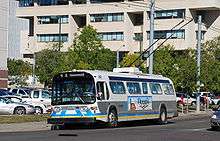
In 1981–82, Brown Boveri & Company constructed 100 model HR150G trolley buses from 40-foot (12.2 m) New Look bus shells for the Edmonton Transit System. Some of these buses remained in use for 27 years, until the Edmonton trolley bus system was shut down in 2009.
A 60-foot (18.3 m) articulated version was designed and built in 1982 for a Government of Ontario demonstration project, but used a Classic front end on the New Look body, and for that reason this model is sometimes not described as being a New Look and is not included in New Look production figures.[6] Series production took place in 1982–1983, and a total of only 53 were built.[6] With a newer front (to allow a wider entrance) and older body, these buses, which were model TA60-102N (for Transit Articulated 60 feet long × 102 inches wide No air conditioning), were a transitional model. Unlike most other articulated buses with an engine in the front section and a powered middle axle, the TA60-102N utilized a "pusher" design that used a conventional New Look drive train and a specially-designed articulated joint that limited the angle between the two section to 7° at normal speeds (while traveling straight forward) and to less than 2° at highway speeds.[7]
Model naming
The model naming for the GM New Look bus is shown below. Examples of model names are TDH-5301, T8H-5305N, T6H-5307N, S6H-4504A, and T6H-4521N. (Note that not all possible combinations were constructed.) The front end of the bus remained essentially the same through the production of the New Look.
| Type | Engine | Transmission | Nominal seating capacity | Series | Air conditioning | |
|---|---|---|---|---|---|---|
| T = transit bus S = suburban bus |
1st & 2nd generation D = diesel G = gasoline 3rd & 4th generation |
H = hydraulic (automatic) transmission M = manual transmission |
- | 33 = 29 feet (8.8 m)3 45 = 35 feet (10.7 m) 53 = 40 feet (12.2 m) |
|
A = Air conditioning N = No air conditioning
|
NOTES:
| ||||||
Description:
| |||||
| Type | Models | Example (TDH-5301 shown) | |||
| Transit |
|
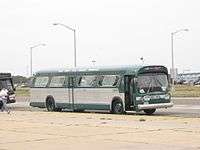 | |||
| Suburban |
| ||||
Description:
| |||||
| Type | Models | Example (TDH-4519 shown) | |||
| Transit |
|
 | |||
| Suburban |
| ||||
Description:
| |||||
| Type | Models | Example (S8M-5303A shown) | |||
| Transit |
|
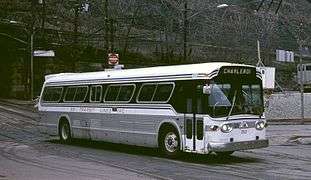 | |||
| Suburban |
| ||||
Description:
| |||||
| Type | Models | Example (T6H-5307N shown) | |||
| Transit |
|
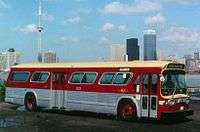 | |||
| Suburban |
| ||||
| NOTES: | |||||
Manufacturing location was indicated by the serial number. No prefix was used for Pontiac, Michigan, C (Canada) indicated London, Ontario, and M (Montreal) Saint-Eustache, Quebec. All buses with 17-digit VINs were built in Saint-Eustache.
Production figures by model
Production totals are through August 1980, when serial numbers changed to 17-digit Vehicle Identification Numbers.[8][9]
Transit
|
Suburban
| ||||||||||||||||||||||||||||||||||||||||||||||||||||||||||||||||||||||||||||||||||||||||||||||||||||||||||||||||||||||||||||||||||||||||||||||||||||||||||||||||||||||||||||||||||||||||||||||||||||||||||||||||||||||||||||||||||||||||||||||||||||||||||||||||||||||||||||||||||||||||||||||||||||||||||||||||
See also
- GM "old-look" transit bus - predecessor model
- Flxible New Look bus - its main competitor
- Rapid Transit Series - one of two successor models
- Classic (transit bus) - the Canadian successor model
- List of buses
- A bus of this series was prominently featured in the 1994 movie Speed.
References
- 1 2 3 4 5 6 Stauss, Ed (1988). The Bus World Encyclopedia of Buses, pp. 29-30 and 94-101. Woodland Hills, CA (USA): Stauss Publications. ISBN 0-9619830-0-0.
- 1 2 3 Stauss (1988), p. 30.
- ↑ Semendinger, David H.; and Robert E. Sauer, Jr. (July–September 2003). "D. C. Transit System" [history of]. Motor Coach Age, p. 9. ISSN 0739-117X.
- ↑ Motor Coach Today, Vol. 5, No. 1 (January–March 1998), p. 9. Motor Bus Society.
- ↑ Tom Spears, Ottawa Citizen (May 14, 2015). "Chrome glory: Old bus still gleaming in Outaouais". Retrieved December 4, 2015.
- 1 2 Stauss (1988), p. 33.
- ↑ The Articulated Bus, Toronto: Toronto Transit Commission, November 1982, p. 4
- ↑ "GM New Look U.S. Production Lists". Coach Manufacturer Production Lists. The Ohio Museum of Transportation. November 15, 2006 (date of last revision). Retrieved September 17, 2012. Check date values in:
|date=(help) - ↑ Alan Gryfe (August 2, 2000). "General Motors Diesel Division Bus Models & Deliveries". Retrieved September 17, 2012.
Bibliography
- Burness, Tad (1985). American Truck & Bus Spotter's Guide, 1920-1985. Osceola, WI (USA): Motorbooks International. ISBN 978-0-87938-198-1.
- Luke, William A. & Metler, Linda L. (2005). City Transit Buses of the 20th Century. Hudson, WI: Iconografix. ISBN 1-58388-146-8.
- McKane, John H. & Squier, Gerald L. (2006). Welcome Aboard the GM New Look Bus. Hudson, WI (USA): Iconografix. ISBN 1-58388-167-0.
- McKane, John H. (1999). The General Motors New Look Bus Photo Archive. Hudson, WI: Iconografix. ISBN 1-58388-007-0.
- Stauss, Ed (1988). The Bus World Encyclopedia of Buses. Woodland Hills, CA (USA): Stauss Publications. ISBN 0-9619830-0-0.
External links
| Wikimedia Commons has media related to GM New Look buses. |
- Information and specifications for GMC buses, Coach Information Network.
- Yahoo GMC New-Look Bus Group
- GM production lists of New Look buses, with serial numbers and original purchasers
- DieselBusParts.com a great resource for bus repair, restoration and free manuals.